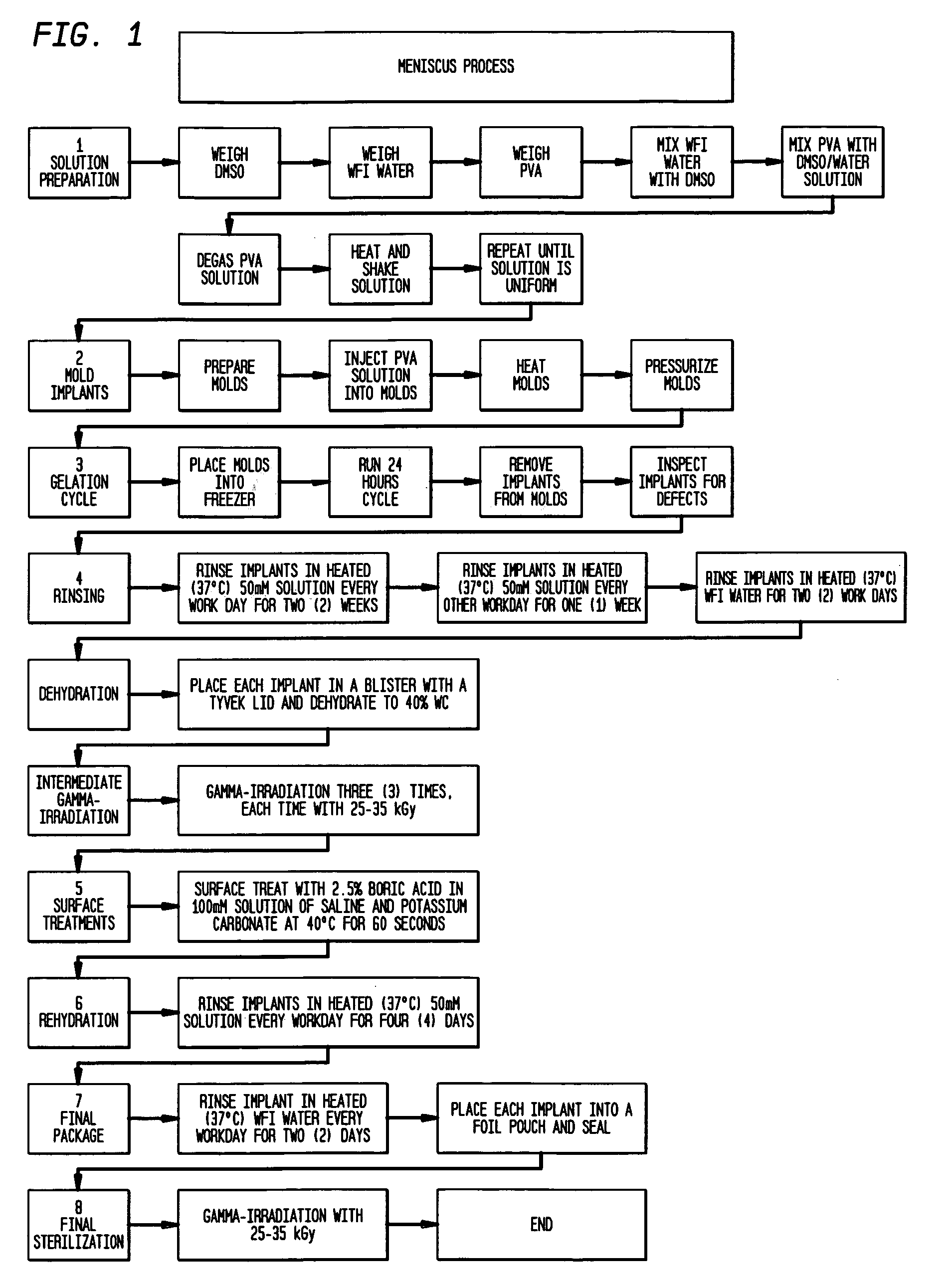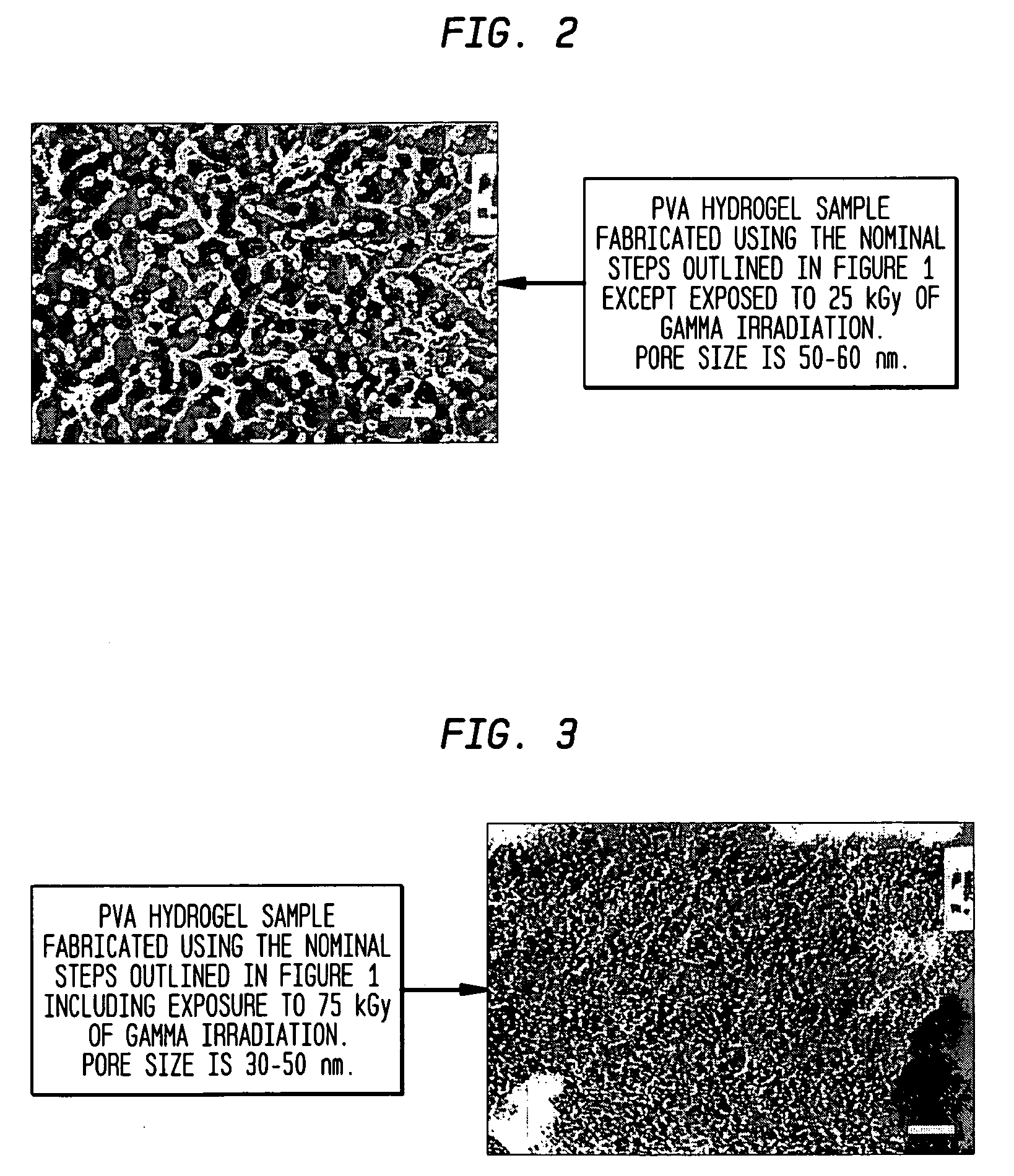Wear resistant hydrogel for bearing applications
a technology of hydrogel and bearing, applied in the field of surgical implants, can solve the problems of affecting the function and mobility of the knee, the implant does not reproduce the mechanical properties of a normal knee, and the typical existing knee replacement lacks the functional features normally provided by the meniscus, so as to improve the wear resistance, and reduce the in vivo equilibrium water content
- Summary
- Abstract
- Description
- Claims
- Application Information
AI Technical Summary
Benefits of technology
Problems solved by technology
Method used
Image
Examples
example i
Formation of Bulk Hydrogel
[0048]The implants used in this study were fabricated in a class 1,000 clean room using the manufacturing flow chart of FIG. 1. The implants were molded from a solution in DMSO / water solvent, a 98.5% hydrolyzed (PVA-117, Kurray, Japan) poly (vinyl alcohol) (PVA) hydrogel that is physically crosslinked through the use of a freezing-thawing technique. This technique includes cooling the hydrogel in the mold to at or below 4° C. and holding at this temperature for 2 to 24 hours and then allowing the mold to warm to room temperature. Any water used in the fabrication of the device was USP Sterile Water-for-Injection (WFI) (Abbott Laboratories, North Chicago, Ill.).
[0049]The process for forming a more highly chemically crosslinked layer on the surface of a hydrogel was also used. This process provides for the formation of a transition zone between the more highly crosslinked surface and the less crosslinked bulk material. This transition zone makes it less likel...
example ii
[0054]Step 1—Form A Bulk Hydrogel as in Example I by forming a solvent of approximately 75 / 25 wt / wt DMSO / water and placing a 15 wt % of PVA polymer was in the solvent.
[0055]The polymer / solvent solution was poured into a mold and the mold was placed in a freezer at below 0° C. preferably for about sixteen (16) hours and more preferably at 20° C. If desired, that freezing can take place for more than 16 hours.
[0056]The formed hydrogel was removed from the mold and placed in a saline solution preferably consisting of sodium chloride and potassium carbonate ions; and the hydrogel was washed in the saline solution preferably for about one week.
[0057]Step 2—Chemically Crosslink Surface Of Hydrogel of Step 1.
[0058]The hydrogel was dehydrated to approximately 40 wt % water saline solution.
[0059]The hydrogel was first irradiated with 10-40 kGy of gamma irradiation.
[0060]The hydrogel was then soaked in 1-5% boric acid in a saline solution for 30 seconds to 6 hours to form chemical crosslinks....
example iii
[0064]In the preferred method, a 15% solution of PVA was created in a solvent of 75 / 25 DMSO / water. A higher concentration of PVA will result in a material with a higher modulus of elasticity.
[0065]The preferred gelation cycle was one 16 hour soak at −20° C. However, up to 5 soak periods from 2 hours-24 hours each at any temperature at or below 4° C. can be used.
[0066]The hydrogel was then rinsed in 0.9% sodium chloride with phosphate buffer plus 50 mM potassium carbonate preferably for approximately 3 weeks. Other salts could also be used in the saline at higher or lower concentrations. Rinsing should proceed until the DMSO has been removed.
[0067]In the preferred embodiment, the hydrogel was then dehydrated to 40% water content and then irradiated with 75 kGy gamma irradiation. If the hydrogel is irradiated at a lower water content, a lower equilibrium water content and higher elastic modulus will result. However, as water content decreases, the effect becomes less pronounced. If le...
PUM
| Property | Measurement | Unit |
|---|---|---|
| water content | aaaaa | aaaaa |
| temperature | aaaaa | aaaaa |
| water content | aaaaa | aaaaa |
Abstract
Description
Claims
Application Information
 Login to View More
Login to View More - R&D
- Intellectual Property
- Life Sciences
- Materials
- Tech Scout
- Unparalleled Data Quality
- Higher Quality Content
- 60% Fewer Hallucinations
Browse by: Latest US Patents, China's latest patents, Technical Efficacy Thesaurus, Application Domain, Technology Topic, Popular Technical Reports.
© 2025 PatSnap. All rights reserved.Legal|Privacy policy|Modern Slavery Act Transparency Statement|Sitemap|About US| Contact US: help@patsnap.com



